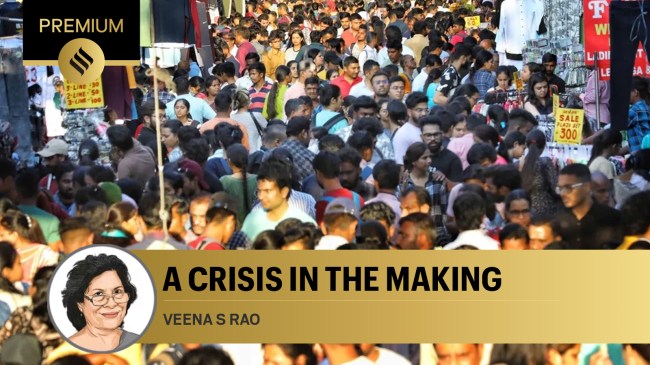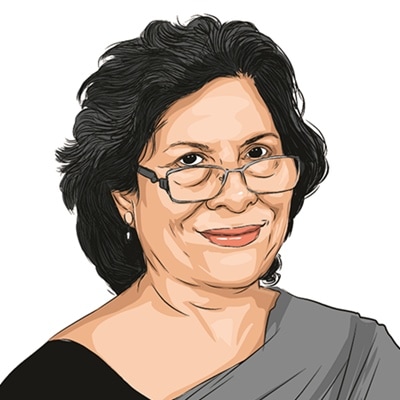Opinion India’s asset-less, ageing population with poor health is a crisis in the making
It is unlikely that a large population will strengthen our economy through high consumption — more likely a large population with low education/skills will increase unemployment, and have little disposable income for high consumption.
 It is unlikely that a large population will strengthen our economy through high consumption — more likely.
It is unlikely that a large population will strengthen our economy through high consumption — more likely. India’s population has reached its demographic prime. Around 67.3 per cent of our population is between 15-59 years of age, a demographic advantage which will persist for another three decades. Approximately 26 per cent of the population is below 14 years, and just 7 per cent above the age of 65, as against 17 per cent in the US and 21 per cent in Europe. By 2030, India’s working age population will reach 68.9 per cent, with a median age of 28.4 years and a dependency ratio of just 31.2 per cent. In absolute numbers, India, with 1.04 billion working age persons, will constitute the largest workforce in the world.
But these large demographic numbers can translate into dividends only with high productivity that drives wealth creation, mainly through high technology, innovative information technology, high-end new-age services, R&D driven innovation, healthcare and life sciences. Does our demographic dividend presently have capacity to achieve this high productivity and wealth creation and achieve our $7 trillion GDP target by 2030? Clearly, this capacity can only develop with right education and skills, which require cognitive power and physical health. Both start developing at foetal stage and continue developing through childhood and adolescence into adulthood, with proper health, nutritional and educational care. Only then can the demographic dividend have the capacity for higher learning, superior skills and qualifications to fit contemporary job requirements.
As per NFHS 5, among our present demographic dividend (15-49 years), only 41 per cent women and 50.2 per cent men have 10 years plus schooling; 57 per cent women and 25 per cent men are anaemic; and 18.7 per cent women and 16.2 per cent men have Body Mass Index below normal. Not surprising therefore, that despite several ongoing skilling programmes, employers are unable to find the skills they want, and unemployment rates of “educated” youth remain high.
Our immediate demographic dividend, 15-19 years adolescent girls and boys, will constitute India’s work-force for the next three decades. Among them, only 34 per cent girls and 35.9 per cent boys of age 15-24 have completed 12 years or more education; 59 per cent girls and 31 per cent boys are anaemic, and only 54.9 per cent girls and 52.6 per cent boys have normal BMI. The Annual Status of Education Report (ASER) (Rural) 2023, found that nationally, only 77 per cent in the 17-18 years category could read Class 2 textbooks, and 35 per cent could do division. Learning trajectory over Grades V, VI, VII and VIII was relatively flat, meaning that there was little difference in learning levels within these grades.
This is our demographic dividend for the next three decades.
It’s not a very bright picture about our future demographic dividend either — our children, who will enter the workforce after a decade or two. As per NFHS 5, 35.5 per cent children below five years are stunted, 19.3 per cent are wasted, 32.1 per cent are underweight; and 67.1 per cent children between 6-59 months are anaemic. (Figures for the two poorest quintiles are almost 50 per cent higher) But most shockingly, only 11.3 per cent children aged 6-23 months receive minimal adequate diet, improved from 9.6 per cent as in NFHS 4. The foundation of our demographic dividend for the next three decades lies here.
Medical science confirms that 90 per cent of a child brain development happens before the age of 5, and lays the physical, mental, and emotional foundations for future life. Optimal brain development therefore becomes the first casualty of the 88.7 per cent children under two, not receiving minimal and adequate diet. India’s routine dietary deficit is well documented in national surveys. Not surprising therefore that the resultant under-nutrition, poor health and morbidity, prevents children and adolescents from achieving their complete cognitive and physical potential, and thereafter prevents them from acquiring the education and skills required for emerging higher end job market.
India will start ageing with each passing year after 2030 with the workforce population declining and the ageing population increasing. A growing skill-less, asset-less, ageing population in poor health can become India’s greatest future burden.
It is unlikely that a large population will strengthen our economy through high consumption — more likely a large population with low education/skills will increase unemployment, and have little disposable income for high consumption. The expected flight of human capital from weaker sections to foreign lands with scarce secondary labour is hardly a solution.
The time for a serious real-time situation analysis of our immediate and future demographic dividend and a redesign our policy framework to strengthen it through the life cycle is now. A sound foundation of better nutrition, health and education will enable our demographic dividend to capitalise future economic and job-market opportunities.
The writer is former Secretary, Government of India





